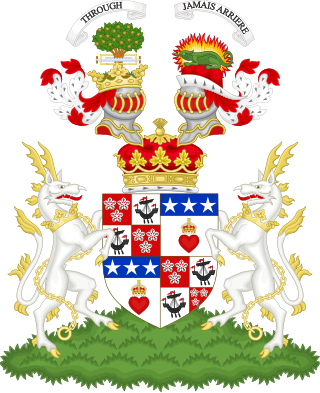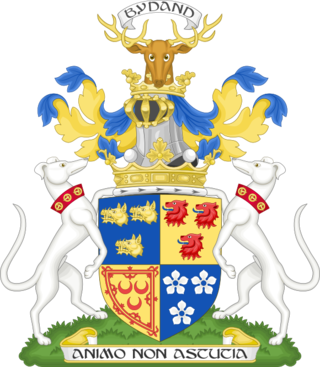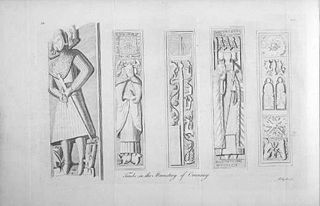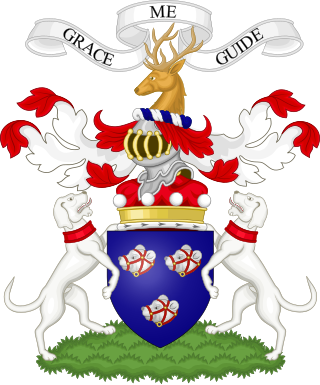
Duke of Hamilton is a title in the Peerage of Scotland, created in April 1643. It is the senior dukedom in that peerage, and as such its holder is the premier peer of Scotland, as well as being head of both the House of Hamilton and the House of Douglas. The title, the town of Hamilton in Lanarkshire, and many places around the world are named after members of the Hamilton family. The ducal family's surname, originally "Hamilton", is now "Douglas-Hamilton". Since 1711, the dukedom has been held together with the Dukedom of Brandon in the Peerage of Great Britain, and the dukes since that time have been styled Duke of Hamilton and Brandon, along with several other subsidiary titles.

Lochaber is a name applied to a part of the Scottish Highlands. Historically, it was a provincial lordship consisting of the parishes of Kilmallie and Kilmonivaig. Lochaber once extended from the Northern shore of Loch Leven, a district called Nether Lochaber, to beyond Spean Bridge and Roybridge, which area is known as Brae Lochaber or Braigh Loch Abar in Gaelic. For local government purposes, the name was used for one of the landward districts of Inverness-shire from 1930 to 1975, and then for one of the districts of the Highland region from 1975 to 1996. Since 1996 the Highland Council has had a Lochaber area committee.

Marquess of Huntly is a title in the Peerage of Scotland that was created on 17 April 1599 for George Gordon, 6th Earl of Huntly. It is the oldest existing marquessate in Scotland, and the second-oldest in the British Isles; only the English marquessate of Winchester is older. The Marquess holds the following subsidiary titles: Lord Gordon of Strathaven and Glenlivet and Earl of Aboyne, and Baron Meldrum, of Morven in the County of Aberdeen.
William Sinclair (1410–1480), 1st Earl of Caithness (1455–1476), last Earl (Jarl) of Orkney, 2nd Lord Sinclair and 11th Baron of Roslin was a Norwegian and Scottish nobleman and the builder of Rosslyn Chapel, in Midlothian.
The Earl or Mormaer of Ross was the ruler of the province of Ross in northern Scotland, as well as chief of Clan Ross.

Clan Donald, also known as Clan MacDonald or Clan Mc Donald, is a Highland Scottish clan and one of the largest Scottish clans. The Lord Lyon King of Arms, the Scottish official with responsibility for regulating heraldry in that country, issuing new grants of coats of arms, and serving as the judge of the Court of the Lord Lyon, recognises under Scottish law the High Chief of Clan Donald. Historically the chiefs of the Clan Donald held the title of Lord of the Isles until 1493 and two of those chiefs also held the title of Earl of Ross until 1476. Queen Mary of Denmark is member of Clan Donald.

Clan Sutherland also known as House of Sutherland is a Highland Scottish clan whose traditional territory is the shire of Sutherland in the far north of Scotland. The chief of the clan was also the powerful Earl of Sutherland; however, in the early 16th century, this title passed through marriage to a younger son of the chief of Clan Gordon. The current chief is Alistair Sutherland, who holds the title Earl of Sutherland.

The Clan MacLellan is a Scottish clan of the Scottish Lowlands. The clan does not currently have a chief therefore it is considered an Armigerous clan. in Edinburgh at the gathering of the clans in 2009 the Maclellan clan were led up the royal mile by Steven McLelland living in carlisle now,

Clan MacDonald of Keppoch, also known as Clan MacDonellof Keppoch or Clan Ranald of Lochaber, is a Highland Scottish clan and a branch of Clan Donald. The progenitor of the clan is Alistair Carrach MacDonald, 4th great-grandson of the warrior Somerled. The clan chief is traditionally designated as the "Son of Ranald's son".
The Clan MacDonald of Lochalsh was a Scottish family and a branch of the larger Clan Donald.

John of Islay was the lord of the Isles (1336–1386) and chief of Clan Donald. In 1336, he styled himself Dominus Insularum, although this was not the first ever recorded instance of the title in use. Some modern historians nevertheless count John as the first of the later medieval lords of the Isles, although this rather broad Latin style corresponds roughly with the older Gaelic title Rí Innse Gall, in use since the Viking Age. For instance, the even more similar Latin title dominus de Inchegal, applied to Raghnall Mac Somhairle in the mid-12th century. In fact John is actually styled Rí Innsi Gall or King of the Isles shortly after his death in a contemporary entry in the Irish Annals of Ulster. Clan Donald considers the title "Lord of the Isles" to have been in use at least since Angus Mor Macdonald, who died in 1293, and the title "King of the Isles" in use since Somerled, the Norse-Gael who forged the Kingdom of the Isles in the 12th century.

Alexander of Islay or Alexander MacDonald was a medieval Scottish nobleman who succeeded his father Domhnall of Islay as Lord of the Isles (1423–1449), later rising to the rank of Earl of Ross (1437–49). His lively career, especially before he attained the earldom of Ross, led Hugh MacDonald, the 17th century author of History of the MacDonalds, to commemorate him as "a man born to much trouble all his lifetime". Alexander allied himself with King James I of Scotland against the power of the Albany Stewarts in 1425 but, once the Albany Stewarts were out of the way, Alexander quickly found himself at odds with the new king. War with King James would initially prove Alexander's undoing, and would see the King's power in Scotland greatly increased, but at the Battle of Inverlochy Alexander's army prevailed against the forces of the King. Alexander died in 1449, having greatly extended his family's landed wealth and power. He was buried, not in the Isles of his ancestors, but at Fortrose Cathedral in his mainland Earldom of Ross.

Clan Forbes is a Highland Scottish clan from Aberdeenshire, Scotland.

Kilmonivaig is a small village, situated close to the southeast end of Loch Lochy in Spean Bridge, Inverness-shire, Scottish Highlands and is in the Scottish council area of Highland.
Alexander Gordon, 3rd Earl of Huntly was a Scottish nobleman. He was a member of Parliament, a member of the Privy Council, a regent and Lieutenant of the kingdom.

Clan Cumming, historically known as Clan Comyn, is a Scottish clan from the central Highlands that played a major role in the history of 13th-century Scotland and in the Wars of Scottish Independence. The Clan Comyn was once the most powerful family in 13th-century Scotland, until they were defeated in civil war by their rival to the Scottish throne, Robert the Bruce.
Amy of Garmoran also known as Amie MacRuari and Euphemia was a 14th-century Scottish noblewoman who was the sister of Raghnall mac Ruaidhri, Lord of Garmoran and the spouse of John of Islay. After her marriage had produced three sons, the ambitious John of Islay divorced her in order to remarry and cement his links with the House of Stewart. She then retired to her estates in the Highlands and Islands, and completed various ecclesiastical and other building projects. Her son Ranald was the progenitor of Clanranald.
Alastair Carragh MacDonald was a son of John of Islay, Lord of the Isles and Margaret Stewart, daughter of King Robert II of Scotland and Elizabeth Mure. He is the eponymous ancestor of Clan MacDonald of Keppoch.

The Alexanders of Menstrie, also known as the House of Alexander, are a sept of Clan MacAlister of Scotland. The family is said to descend from Somerled, Lord of the Isles. The seat of the clan was at Menstrie Castle in Menstrie, Clackmannanshire. Descendants of the Alexanders of Menstrie have become prominent in Ireland, England and the United States.













